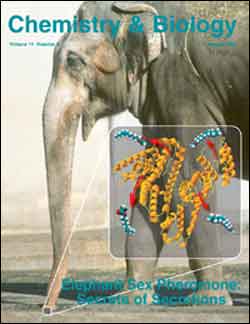Asian elephant sex pheromone transporter revealed

In this issue of Chemistry & Biology, Lazar and colleagues report an unexpected finding about pheromone transport in the Asian elephant, an endangered species of which only a few thousand individuals remain.
Female elephants communicate their readiness to mate by excreting a sex pheromone in their urine. Male elephants exhibit a range of responses to this pheromone, beginning with sniffing and “check and place” responses, where the male touches his trunk tip to the pheromone-loaded urine. Next, the male places the pheromone urine in his mouth, in a behavior known as flehmen, after which mating behavior typically ensues. The sex pheromone therefore has to travel through and survive a number of different environments, from serum to urine to mucus, for successful mating to occur. The authors have discovered that serum albumin, a ubiquitous vertebrate protein, plays an unexpected and multifaceted role as a shuttle that both protects and transports the pheromone. The authors reveal that elephant serum albumin (ESA) transports the pheromone from serum to urine and it extends the period of time that the pheromone remains available for detection in the environment, without actually masking the pheromone and hampering detection. Dissociation of the pheromone-ESA complex is induced by the low pH environment of the male elephant truck and enhances detection by producing a pulse of the volatile pheromone as the male elephant performs the characteristic flehmen behavior.
Use of albumin in urinary pheromone transport is distinct from other mammalian pheromone transport systems studied so far. Furthermore, the exploitation of albumin in pheromone transport complements the particular lifestyle of Asian elephants by reflecting the uniqueness of elephant anatomy, physiology, and behavior.
Media Contact
More Information:
http://www.cell.comAll latest news from the category: Life Sciences and Chemistry
Articles and reports from the Life Sciences and chemistry area deal with applied and basic research into modern biology, chemistry and human medicine.
Valuable information can be found on a range of life sciences fields including bacteriology, biochemistry, bionics, bioinformatics, biophysics, biotechnology, genetics, geobotany, human biology, marine biology, microbiology, molecular biology, cellular biology, zoology, bioinorganic chemistry, microchemistry and environmental chemistry.
Newest articles

Superradiant atoms could push the boundaries of how precisely time can be measured
Superradiant atoms can help us measure time more precisely than ever. In a new study, researchers from the University of Copenhagen present a new method for measuring the time interval,…

Ion thermoelectric conversion devices for near room temperature
The electrode sheet of the thermoelectric device consists of ionic hydrogel, which is sandwiched between the electrodes to form, and the Prussian blue on the electrode undergoes a redox reaction…

Zap Energy achieves 37-million-degree temperatures in a compact device
New publication reports record electron temperatures for a small-scale, sheared-flow-stabilized Z-pinch fusion device. In the nine decades since humans first produced fusion reactions, only a few fusion technologies have demonstrated…





















